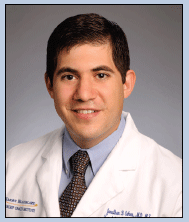A Plethora of Novel Therapies-Which One to Choose?
While the headliners for the 2015 ASCO Annual Meeting featured mainly immunologic approaches to cancer treatment, with agents such as nivolumab and ipilimumab, the new data in hematologic malignancies highlighted a large number of novel therapies, each of which appears promising.
Jonathon B. Cohen, MD, MS

Christopher R. Flowers, MD, MS

Inside ASCO 2015: Hematologic Malignancies
While the headliners for the 2015 ASCO Annual Meeting featured mainly immunologic approaches to cancer treatment, with agents such as nivolumab and ipilimumab, the new data in hematologic malignancies highlighted a large number of novel therapies, each of which appears promising. Although this remains an exciting time in the management of these disorders, it is becoming increasingly challenging to identify the most appropriate therapies for an individual patient. Improvement in molecular diagnostics, leading to the possibility of personalized treatment plans, is sorely needed.
New agents, new combinations for lymphoma
In the lymphoma oral abstract session, for example, we heard presentations describing an anti-79b antibody-drug conjugate,[1] an anti-CD19 monoclonal antibody,[2] and a novel triplet combination of ibrutinib, TGR-1202 (a PI3K inhibitor), and ublituximab (an anti-CD20 monoclonal antibody).[3] These findings were in addition to results with other novel combinations that were presented in the poster session, including the Bcl-2 inhibitor venetoclax in combination with rituximab and bendamustine in relapsed/refractory non-Hodgkin lymphoma,[4] as well as a non–ibrutinib-containing doublet of ublituximab and TGR-1202.[5] As these agents progress through the developmental therapeutic pathway to larger-scale studies and ultimately FDA approval, it will be incumbent on the lymphoma community to provide guidance on the appropriate selection and sequencing of novel therapies.
An explosion in new options for multiple myeloma
The multiple myeloma community has seen a remarkable increase in effective therapies over the past several years, and investigators continue to evaluate upfront treatment options, the role of autologous transplant, and maintenance approaches. While multiple myeloma has traditionally not had effective monoclonal antibody–based approaches, outcomes of trials featuring two novel antibodies were presented. Elotuzumab and daratumumab represent novel approaches and are both very promising; they are now being evaluated both alone and in combination. Elotuzumab, for example, is associated with a significantly improved progression-free survival (PFS) when combined with lenalidomide and dexamethasone in the relapsed/refractory setting, compared with lenalidomide/dexamethasone alone.[6] Single agent daratumumab, assessed in a heavily pretreated population of patients with multiple myeloma, had an overall response rate of 29.2%, with 3 complete responses (CRs) and several durable remissions.[7] This anti-CD38 antibody was featured in several Trials in Progress presentations, since it is being evaluated in a number of combination studies.[8,9] The numerous effective therapies for multiple myeloma will require a re-appraisal of the most appropriate sequence of therapies and upfront management of patients.
In leukemia: a new prognostic marker
The leukemia community has made great strides in the development of a personalized prognostic approach to newly diagnosed patients with acute leukemia, even though the therapeutic advances require additional development in this regard. As a result, numerous prognostic subsets of leukemia patients with identified molecular abnormalities and therapeutic targets have been described; however, there are not well-established therapy options correlated to these pretreatment assessments. An example of the encouraging progress being made in our ability to personalize treatment for leukemia patients is the study presented by Gerber et al, which described leukemia stem cell phenotypes and their association with prognosis in patients with acute myeloid leukemia.[10] This assessment, which included the CD34, CD38, and aldehyde dehydrogenase phenotypes, proved instrumental in identifying patients at high risk for treatment failure and merits further evaluation. Novel therapies for acute myeloid leukemia, including ASP2215,[11] were described and continue to show promise, although none appear poised to supplant current approaches to newly diagnosed and relapsed acute myeloid leukemia.
New surrogate endpoint may speed research results
Perhaps the work most likely to result in long-term changes in our approach to the assessment of novel therapies and patient outcomes in hematologic malignancies was Dr. Sargent and colleagues’ impressive report of the FLASH analysis, which identified the rate of CR at 30 months as a surrogate for PFS in the front-line management of follicular lymphoma.[12] This analysis combined 13 randomized first-line trials and included independent patient data for 3,837 patients; it represents an opportunity for continued improvement in the front-line management of follicular lymphoma. While the current median PFS among modern trials is more than 7 years, nearly all patients relapse. However, the lymphoma community has been a victim of its own success, since the prolonged PFS results in a significant delay in reporting the primary endpoints for current trials and makes progress difficult. As a result, the findings of the Sargent et al analysis may inform a new generation of upfront studies in follicular lymphoma that may lengthen the PFS even further.
Ultimately, the 2015 ASCO Annual Meeting included numerous novel therapies and new approaches to the evaluation and management of hematologic malignancies. Although the findings presented may not be immediately applicable to clinical practice, investigators’ continued efforts to evaluate novel therapies-and patients’ continued willingness to consider enrolling in clinical trials-are moving the field forward to a day when patients will have numerous effective therapy options, including, hopefully, an increased number of curative options. It will remain incumbent on the research community to combine molecular, personalized risk-stratification and assessment of predictive markers with the development of novel therapies that can be applied to specific subsets of patients, thereby allowing us to achieve our goal of providing a personalized approach for each patient.
Financial Disclosure:Dr. Flowers is an upaid consultant for Celgene, Genentech/Roche, and Gilead, and also consults for OptumRx. He reports research support from AbbVie, Acerta, the Eastern Cooperative Oncology Group, Genentech, Gilead, Infinity, the Mayo Clinic, Millennium/Takeda, Onyx, Pharmacyclics, and TG Therapeutics. Dr. Cohen has consulted for Celgene, Millennium, Takeda, and Pharmacyclics, and he has received research funding from Bristol-Myers Squibb and Pharmacyclics.
References:
1. Advani RH, Flinn I, Sharman JP, et al. Two doses of polatuzumab vedotin (PoV, anti-CD79b antibody-drug conjugate) in patients (pts) with relapsed/refractory (RR) follicular lymphoma (FL): durable responses at lower dose level. Presented at the American Society of Clinical Oncology Annual Meeting; May 29-June 2, 2015; Chicago. Abstr 8503.
2. Jurczak W, Zinzani PL, Goy A, et al. Phase IIa study of single-agent MOR208 in patients with relapsed or refractory B-cell non-Hodgkin’s lymphoma (NHL). Presented at the American Society of Clinical Oncology Annual Meeting; May 29-June 2, 2015; Chicago. Abstr 8500.
3. Fowler NH, Nastoupil LJ, Lunning MA, et al. Safety and activity of the chemotherapy-free triplet of ublituximab, TGR-1202, and ibrutinib in relapsed B-cell malignancies. Presented at the American Society of Clinical Oncology Annual Meeting; May 29-June 2, 2015; Chicago. Abstr 8501.
4. De Vos S, Flowers C, Wang D, et al. Interim results from a dose-escalation study of the BCL-2 inhibitor venetoclax (ABT-199/GDC-0199) plus bendamustine (B) and rituximab (R) in patients (pts) with relapsed/refractory (R/R) non-Hodgkin’s lymphoma (NHL). Presented at the American Society of Clinical Oncology Annual Meeting; May 29-June 2, 2015; Chicago. Abstr 8535.
5. Lunning MA, Vose J, Fowler NH, et al. Ublituximab plus TGR-1202 activity and safety profile in relapsed/refractory B-cell NHL and high-risk CLL. Presented at the American Society of Clinical Oncology Annual Meeting; May 29-June 2, 2015; Chicago. Abstr 8548.
6. Lonial S, Vij R, Harousseau J, et al. Elotuzumab in combination with lenalidomide and low-dose dexamethasone in relapsed or refractory multiple myeloma: a phase I/II study. Presented at the American Society of Clinical Oncology Annual Meeting; May 29-June 2, 2015; Chicago. Abstr 8020.
7. Lonial S, Weiss BM, Usmani SZ, et al. Phase II study of daratumumab (DARA) monotherapy in patients with ≥ 3 lines of prior therapy or double refractory multiple myeloma (MM): 54767414MMY2002 (Sirius). Presented at the American Society of Clinical Oncology Annual Meeting; May 29-June 2, 2015; Chicago. Abstr LBA8512.
8. Mateos MV, Cavo M, Jakubowiak AJ, et al. A randomized open-label study of bortezomib, melphalan, and prednisone (VMP) versus daratumumab (DARA) plus VMP in patients with previously untreated multiple myeloma (MM) who are ineligible for high-dose therapy: 54767414MMY3007 (Alcyone). Presented at the American Society of Clinical Oncology Annual Meeting; May 29-June 2, 2015; Chicago. Abstr TPS8608.
9. Palumbo A, Dimopoulos MA, Reece DE, et al. Twin randomized studies of daratumumab (DARA; D) plus standard of care (lenalidomide/dexamethasone or bortezomib/dexamethasone [DRd or DVd]) versus Rd or Vd alone in relapsed or refractory multiple myeloma (MM): 54767414MMY3003 (Pollux) and 54767414MMY3004 (Castor). Presented at the American Society of Clinical Oncology Annual Meeting; May 29-June 2, 2015; Chicago. Abstr TPS8609.
10. Gerber JM, Zeidner JF, Morse S, et al. Correlation of acute myeloid leukemia (AML) stem cell phenotype with cytogenetic/molecular features and prognosis. Presented at the American Society of Clinical Oncology Annual Meeting; May 29-June 2, 2015; Chicago. Abstr 7000.
11. Levis MJ, Perl AE, Altman JK, et al. Results of a first-in-human, phase I/II trial of ASP2215, a selective, potent inhibitor of FLT3/Axl in patients with relapsed or refractory (R/R) acute myeloid leukemia (AML). Presented at the American Society of Clinical Oncology Annual Meeting; May 29-June 2, 2015; Chicago. Abstr 7003.
12. Sargent DJ, Shi Q, De Bedout S, et al. Evaluation of complete response rate at 30 months (CR30) as a surrogate for progression-free survival (PFS) in first-line follicular lymphoma (FL) studies: Results from the prospectively specified Follicular Lymphoma Analysis of Surrogacy Hypothesis (FLASH) analysis with individual patient data (IPD) of 3,837 patients (pts). Presented at the American Society of Clinical Oncology Annual Meeting; May 29-June 2, 2015; Chicago. Abstr 8504.
Navigating AE Management for Cellular Therapy Across Hematologic Cancers
A panel of clinical pharmacists discussed strategies for mitigating toxicities across different multiple myeloma, lymphoma, and leukemia populations.